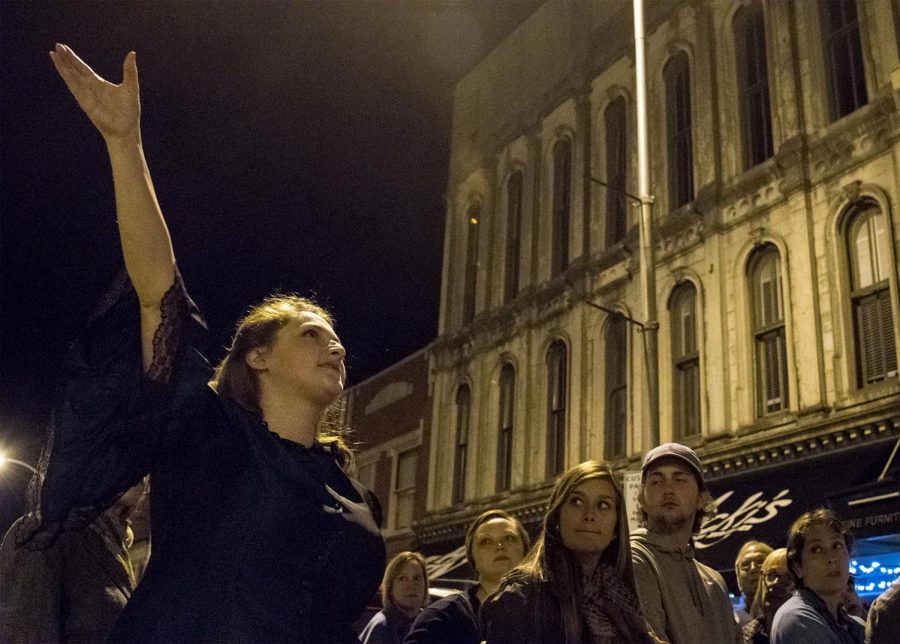History, folklore and the supernatural clash in Unseen Bowling Green
October 31, 2016
A GHOSTLY TOUR
A crowd gathered outside Spencer’s Coffee on Friday night before Halloween; people, young and old, came not for a nighttime pick-me-up but for Unseen Bowling Green, a guided tour around the downtown area that reveals the darker side of Bowling Green’s history.
The tour’s founder and narrator, Kara Williams Glenn, took the crowd around downtown. She dressed for the occasion in a historic green dress with spooky music accompanying her.
She took the crowd by the law office of Pamela C. Bratcher, explaining how the building used to be a funeral home, where the owner had to constantly make caskets during the Civil War. He made so many caskets he went mad, Glenn said. According to eyewitness accounts, the ghost of the man making caskets can still be heard today from the third window on the second floor.
The tour gathered by the window, a normal part of a historic building that had suddenly become much more sinister.
Glenn delved further into the troubled history of Bowling Green when she stood by the courthouse and told the story of Bob Harper, an African-American who was lynched by a mob after being accused of assaulting 17-year-old Kate Anderson. The mob interrupted Harper’s trial, and to this day, it’s unknown if Harper was guilty.
Later, Glenn told about the hauntings of the now closed restaurant Tea Bayou. Its owners lived on the second floor, and spirits allegedly took photographs from family portraits and laid it on the table. There were also reports of Earl Grey tea being toppled over without any cause. The building’s original owner, Simon Settle, may have been English.
While most of Glenn’s story came from eyewitnesses or historical documentation, some of her tales were folkloric. The second floor on 440 Main is an apartment, and a ghost named Mary is said to haunt it. According to legend, Mary loved books, but died tragically, with the cause of death varying depending on who tells the story. Mary’s books were left in the apartment, and her ghost would allegedly hurl objects should one disturb it. The legends say there is one way to stop Mary from haunting.
“Mary, go read your books!” Glenn shouts, stomping her foot. Yelling this puts Mary’s ghost to rest for a while, according to legend.
Besides a walk around downtown, tourists were able to explore a secret location undisclosed to the public, where they spent three minutes inside with flashlights. The tour ended at Pioneer Cemetery, a historic cemetery and resting place of many Civil War soldiers and some of the people in Bowling Green’s history. There have been alleged ghost sightings at Pioneer Cemetery, including sounds of a gravedigger digging a fresh grave.
While these stories may sound gruesome to some, Glenn believes residents should learn about them.
“Many don’t know there was a darker side to Bowling Green,” Glenn said.
Glenn and her husband founded Unseen Bowling Green after speaking to owners of some of the downtown businesses and looking up historical documents to make sure her ghost stories have evidence.
Until starting the tour two years ago, Glenn had not had any personal ghost experiences. But when she was investigating Tea Bayou, she felt something behind her, despite the room being empty. The spirit allegedly followed her home and opened her front door.
Shelby Rice, who assists Glenn during the tour, is more of a skeptic. However, she has had unusual encounters. During one tour, she heard someone whispering behind her, along with unusual warm air. Rice said there may have been a natural explanation for that, but it still spooked her.
“I got freaked out and ran out of the tour,” Rice said. “I had to work myself up to go back in.”
10 percent of all ticket sales go to the Landmark Association, which helps preserve many of the landmarks to which Unseen Bowling Green takes its tourists. Glenn believes the tour will also help a new generation learn the history of Bowling Green.
“We felt like it was important to continue the history of oral storytelling,” she said. “We hope you hear these stories and tell your children.”
Reporter Adam Sims can be reached at 270-745-2655 and [email protected]. Follow him on Twitter at @AdamSimsWriter.




















![Megan Inman of Tennessee cries after embracing Drag performer and transgender advocate Jasmine St. James at the 9th Annual WKU Housing and Residence Life Drag Show at Knicely Conference Center on April 4, 2024. “[The community] was so warm and welcoming when I came out, if it wasn’t for the queens I wouldn’t be here,” Inman said.](https://wkuherald.com/wp-content/uploads/2024/04/smith_von_drag_3-600x419.jpg)


